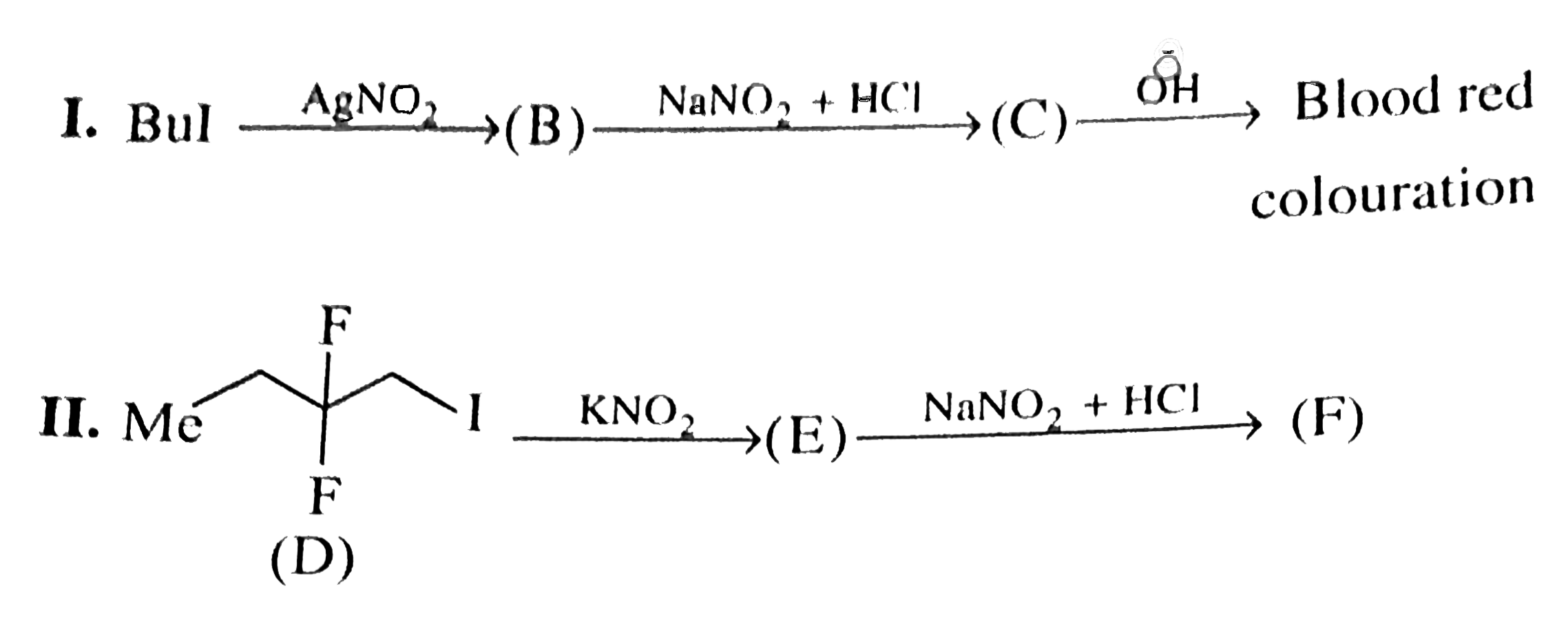
Compound (F) is:


No reaction
Both (a) and (b)
The correct Answer is:c
RX in (I) gives R−NO2 while in (II) it gives R−O−N=O
(For explanation, see Solved Example 11.10)


Topper's Solved these Questions
- AROMATIC COMPOUNDS AND ALKYL AND ARYL HALIDES BOOK - CENGAGE CHEMISTRY ENGLISHCHAPTER - AROMATIC COMPOUNDS AND ALKYL AND ARYL HALIDES EXERCISE - Exercises Linked Compreshension Type
11 Videos
- AROMATIC COMPOUNDS AND ALKYL AND ARYL HALIDES BOOK - CENGAGE CHEMISTRY ENGLISHCHAPTER - AROMATIC COMPOUNDS AND ALKYL AND ARYL HALIDES EXERCISE - Exercises Multiple Correct
32 Videos
- AROMATIC COMPOUNDS AND ALKYL AND ARYL HALIDES BOOK - CENGAGE CHEMISTRY ENGLISHCHAPTER - AROMATIC COMPOUNDS AND ALKYL AND ARYL HALIDES EXERCISE - Exercises Concept Application
4 Videos
- APPENDIX INORGANIC VOLUME 2BOOK - CENGAGE CHEMISTRY ENGLISHCHAPTER - APPENDIX INORGANIC VOLUME 2EXERCISE - Short Answer Type
179 Videos
- BIOMOLECULESBOOK - CENGAGE CHEMISTRY ENGLISHCHAPTER - BIOMOLECULESEXERCISE - Exercises Archives (Analytical And Descriptive)
8 Videos
Similar Questions
Four isomeric optically active compounds NaHCO3−−−−−→CO2(g)(A,B,C,D)(C4H8O3)
Compound (A)LAH−−→(E) (Archiral compound)
Compound (B)KMnO4−−−−−→orCrO3 Inert to oxidation.
Compound (C)−−−−−−−−→NaOI/H3O⊕CHI3(Yellowppt.)+Compound(F).
Compound (D) is :
View SolutionFour isomeric optically active compounds NaHCO3−−−−−→CO2(g)(A,B,C,D)(C4H8O3)
Compound (A)LAH−−→(E) (Archiral compound)
Compound (B)KMnO4−−−−−→orCrO3 Inert to oxidation.
Compound (C)−−−−−−−−→NaOI/H3O⊕CHI3(Yellowppt.)+Compound(F).
Compound (B) is :
View SolutionCompound (x)(m.f=C7H8N), on reaction with NaNO2 and conc. HCl at O∘C followed by β− naphthol gives orange coloured dye. Compound (x) is :
View SolutionFour isomeric optically active compounds NaHCO3−−−−−→CO2(g)(A,B,C,D)(C4H8O3)
Compound (A)LAH−−→(E) (Archiral compound)
Compound (B)KMnO4−−−−−→orCrO3 Inert to oxidation.
Compound (C)−−−−−−−−→NaOI/H3O⊕CHI3(Yellowppt.)+Compound(F).
Compound (C) is :
View SolutionAn aliphatic unsaturated hydrocarbon (A) when treated with HgS∅H2SO4 yields a compound (B) having molecular formula C3H6O. (B) on oxidation with concentrated HNO3 gives two compounds (C) and (D). Compound (C) when treated with PCl5 gives compound (E). (E) when reacts with ethanol gives a sweet-smelling liquid (F). Compound (F) is also formed when (C) reacts with ethanol in the presence of concentrated H2SO4.
(i) Identify the compound A, B, C, D, E and F.
(ii) Give the chemical equation for the reaction of (C) with chlorine in the presence of red phosphorus and name the reaction.
View SolutionColemanite+Na2CO3Fused−−→(A)+(B)+CO2
(A)Solution+CO2→(B)+Na2CO3
(B)+concHCl→NaCl+(C)Acid
(C)Acid+H2O→(D)Acid
(D)Strong heating−−−−−−−−→(E)
(E)+CuSO4Heated−−−→inflame(F)Blue-coloured compound.
Compound (A) is.
View SolutionColemanite+Na2CO3Fused−−→(A)+(B)+CO2
(A)Solution+CO2→(B)+Na2CO3
(B)+concHCl→NaCl+(C)Acid
(C)Acid+H2O→(D)Acid
(D)Strong heating−−−−−−−−→(E)
(E)+CuSO4Heated−−−→inflame(F)Blue-coloured compound.
Compound (B) is.
View SolutionColemanite+Na2CO3Fused−−→(A)+(B)+CO2
(A)Solution+CO2→(B)+Na2CO3
(B)+concHCl→NaCl+(C)Acid
(C)Acid+H2O→(D)Acid
(D)Strong heating−−−−−−−−→(E)
(E)+CuSO4Heated−−−→inflame(F)Blue-coloured compound.
Compound (D) is.
View SolutionColemanite+Na2CO3Fused−−→(A)+(B)+CO2
(A)Solution+CO2→(B)+Na2CO3
(B)+concHCl→NaCl+(C)Acid
(C)Acid+H2O→(D)Acid
(D)Strong heating−−−−−−−−→(E)
(E)+CuSO4Heated−−−→inflame(F)Blue-coloured compound.
Compound (C) is.
View SolutionColemanite+Na2CO3Fused−−→(A)+(B)+CO2
(A)Solution+CO2→(B)+Na2CO3
(B)+concHCl→NaCl+(C)Acid
(C)Acid+H2O→(D)Acid
(D)Strong heating−−−−−−−−→(E)
(E)+CuSO4Heated−−−→inflame(F)Blue-coloured compound.
Compound (E) is.
View Solution
